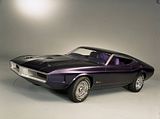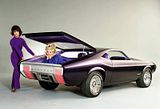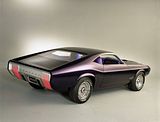Meet the 1970 Ford Mustang Milano ConceptAmie Williams, Associate Online Editor, Mustang 360° December 2, 2013, Photos By: Ford Archives Over the last five decades the Ford Mustang has been the subject of many design renderings. Luckily a lot of those drawings didn’t make it too far past the drawing board. One Mustang concept that came about was the 1970 Mustang Milano. Back in 1970, Ford brought the Milano Mustang to the Chicago Auto Show to showcase the design that was to be featured in the upcoming production ’71 Ford Mustang. Hence the name Milano, this Ultra Violet coupe was inspired by the pro-touring vehicles that drove around the northern Italian city by that same name. This new Mustang design featured just two seats and an almost horizontal fastback. According to Ford, this was the most “radical” Mustang seen up to that time. Let’s say that if Ford forgot to apply running pony badges to the grille and fenders, many people might not realize that this car derived directly from the 1970 Mustang SportsRoof. The rear glass of the Mustang was sloped at 67 degrees and sported an almost horizontal electronically-powered rear decklid. The hood featured NACA-style ducts, which helped force air down into the engine. At higher speeds, the rear spoiler helped plant the power down to the rear wheels. Another feature unheard of was the color-changing tail lamps that glowed green during acceleration, red when the brakes were applied, and then turned back to amber when coasting. The brakes hid behind cast-aluminum wheels with a design that mimicked the classic wire wheels, but were made to be much stronger. Similar looking wheels became popular over the next three decades. If you didn’t get enough purple with the exterior, the interior was also covered in the royal hue. The seats featured purple leather with blue-violet cloth inserts and deep purple mohair carpeting. Ah, the ‘70s! While this exact car didn’t make the production cut, design elements were taken from the Milano for the 1971 production Mustang model. Not only did the car influence the American Mustang market, it also helped with the Australian ‘74 Falcon XB coupe, the car used in the first two Mad Max movies.
|
|





